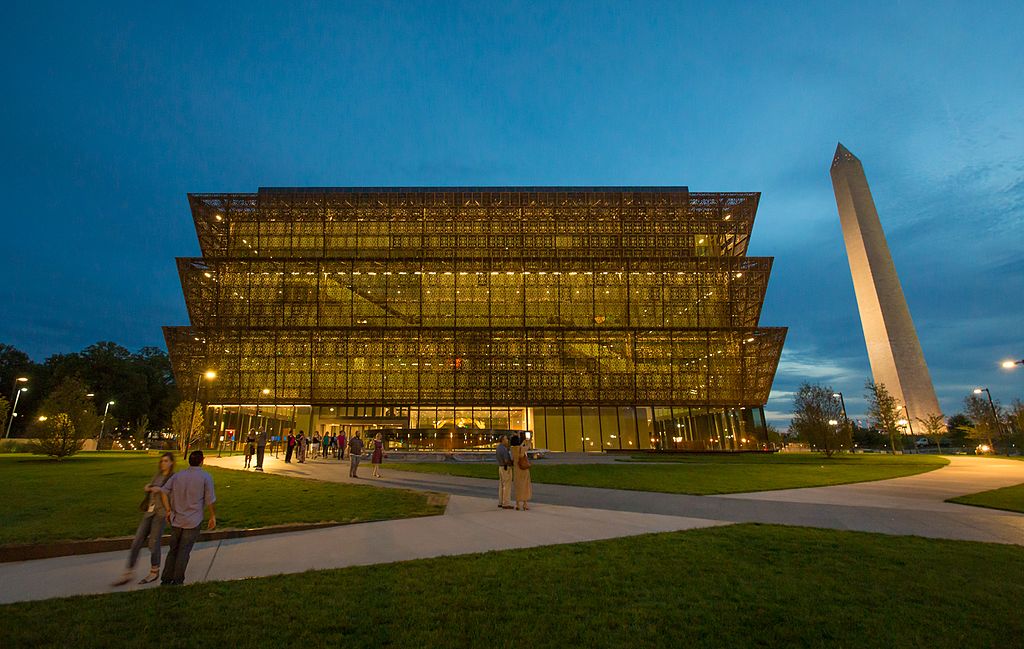
Throughout Black History Month this February, Pratt Institute’s news page and social media are highlighting the important initiatives and accomplishments of some of the Institute’s alumni, faculty, and students in working to preserve and share Black history. From the fashion industry to national cultural institutions and monuments, discover just a few of Pratt’s amazing community members and their achievements.
This story highlights the pivotal work of Pratt alumni in the creation of the National Museum of African American History and Culture in Washington, DC. Check the pratt.edu news page for additional stories that will be posted through the end of Black History Month, or follow on social media by searching the hashtag #BAPBlackHistory.
Almost five million visitors have experienced the National Museum of African American History and Culture (NMAAHC) since it opened in the fall of 2016. The 400,000-square-foot museum on the National Mall in Washington, DC explores the African American story through art, artifacts, literature, and personal narratives.
The establishment of NMAAHC was years in the making. One of the people vital in its creation was Pratt alumna Claudine K. Brown, BFA Fashion '71, who joined the Smithsonian Institution in 1990 as the director of the National African American Museum Project. She led the advisory committees that evaluated the Smithsonian’s role in the proposed museum, and developed a study and program plan for its implementation. One recommendation was that the Arts and Industries Building, which at one time housed the U.S. National Museum, be its temporary home.
In this building, Brown presented a visual argument for the museum. With major input from artist, scholar, and Pratt alumna Deborah Willis, MFA ‘80, the National African American Museum Project organized the 1994-95 exhibition Imagining Families: Images and Voices. The show featured work by artists including Lorna Simpson, Lorie Novak, Pat Ward Williams, and Carrie Mae Weems that explored the theme of family, demonstrating not just the strength of potential art for a museum, but how its subjects could have universal resonance.
Brown left the Smithsonian in 1995, then returned in 2010 as its director of education. Meanwhile, the museum was given new momentum with the 2001 signing by President George W. Bush of the NMAAHC Plan for Action Presidential Commission. Brown was named vice chair of this commission, and many of the ideas that she initiated in the 1990s, such as the use of art and photography as a lens to examine the past, were integrated into the planning.
The NMAAHC opened a few months after Brown’s death in March 2016. Its striking appearance, with a three-tiered inverted ziggurat covered in 3,600 bronze-colored aluminum panels, was designed by architect David Adjaye’s Adjaye Associates with Freelon Group and Davis Brody Bond. In 2011, Adjaye was honored at The Black Alumni of Pratt’s Celebration of the Creative Spirit Scholarship Benefit Gala.
Inside NMAAHC are 12 galleries in 85,000 square feet of exhibition space. Ralph Appelbaum Associates, the museum exhibition design firm founded by Pratt alumnus Ralph Appelbaum, designed the galleries, with their team including Pratt alumni Aki Carpenter as lead art director, Rio Rocket Valledor as senior exhibit designer, Matthew Krupanski as exhibit designer, and Tishon Woolcock as graphic designer, as well as Pratt Visiting Associate Professor of Interior Design LaToya Nelson Kamdang as exhibit designer. While each section is distinct—such as examinations of the struggle for civil rights and the diversity of cultural expressions—threads of story link them into a cohesive journey. NMAAHC now has over 36,000 artifacts and counting, and has become one of the most visited history museums in the nation’s capital.
Read additional Black History Is Pratt History articles: The Studio Museum in Harlem and Black Dress: Salon.
There are a number of events taking place across campus in celebration of Black History Month, including a panel discussion on Design as Social Practice; Graduate Center for Planning and the Environment lecture series events, 400 Years of Inequality and Forging a New Social Contract; a festive evening featuring a conversation with the fashion designer Byron Lars, Black Dress: Salon; and the first film screening of the Diverse Voices Film Series, The Hate U Give, curated by the Film/Video Department and sponsored by the Center for Equity & Inclusion.
Image: Macfawlty, Wikimedia Commons. This file is licensed under the Creative CommonsAttribution-Share Alike 4.0 Internationallicense.